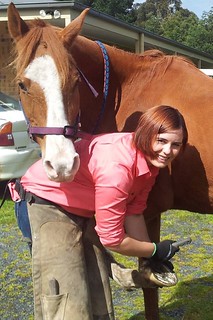My farrier Emily Dux runs a business known as Firm Foundations Hoof Care. My boy is always barefoot so it’s great to have found a farrier that is enthusiastic about this form of trimming and hoof care. Emily kindly took the time to answer some questions about her profession.
Have you always been interested in horses and when did you start out in the industry? What is it exactly that you do?
I have always loved horses and riding, and got my first horse when I was 12. I did cert II equine Studies during VCE and after school I worked at a youth camp where I mostly taught riding, but also helped out with trimming the horses hooves as I had the experience of trimming my own horses for quite a few years.
When my time there was finished I had decided I wanted to be a trimmer and learn how to do a correct barefoot trim and not just what other people/farriers told me to do. I wanted to learn right from the source and find out all the info behind why we should and shouldn’t trim in certain ways. This led me to study a course in Natural Hoof Care and now I’m working as a Hoof Care Practitioner (more commonly known as a ‘Barefoot Trimmer’).

People often ask me ‘what is the difference between a barefoot trim and a farrier trim?’ Well, this really depends on the individual trimmer and farrier. Having not studied a farrier course or seen a farrier trim for a long time, I cant really answer that side of the question without making assumptions that may or may not be true, but through my studies, I learnt to trim based on the ‘natural’ hoof – starting by looking at the desert brumbies with their healthy naturally trimmed hooves due to the many miles they must travel daily in search of food and water.
All the while, our domestic horses generally live on grass rich in sugar, and they don’t get a lot of movement as they don’t need to look for their own feed. As a result their hooves require assistance in trimming.
Usually, it is just a matter of following the guidelines that the hoof gives us – scraping away excess sole, trimming the bars so that they do not become weight bearing and trimming the heels and wall according to the height of the sole ensuring we end up with a nice little arch/scoop at the quarters. If the quarters were left long and touching the ground, this would create unnecessary force within the wall which can lead to cracks, separation and many other problems.
I don’t shoe horses, shoeing can cause numerous problems in the hoof over time due to not allowing the hoof to expand (when weight bearing) and contract (when lifted from the ground). A shod hoof will usually feel cold, unlike a bare hoof which continuously has blood pumping through it as the horse walks. Shoeing may be the easiest option for many people, but my interest lies in the healthiest long term option for the horse. Most of the time, all an unhealthy hoof needs is regular, proper trimming to encourage correct growth, and time to allow the old unhealthy hoof grow out.
How much of your day/week is related to horses?
At the moment I only trim horses part time but I hope for this to become a full time job. I often trim horses in the mornings, or sometimes have a full day working, and then in the afternoons I have time to work my horses. And when you include rugging/feeding twice daily, my days are pretty much ALL about horses.
In this field of work, is it possible to be a full time professional and earning a liveable income?
Definitely!! Hoof care is one of the most regular services a horse needs so there is always a need for Hoof care providers.
What are the general steps taken to be employed in such a role?
Firstly you need to decide what kind of hoof care provider you would like to be. To be a farrier, you will need to do an apprenticeship (4 years I believe). Whereas a Trimmer can become qualified in 1 or 2 years of Study, most of which can be done from home with help from mentors in your area. Once qualified, you can set up your business and be patient as your name gets about and your client base grows. Most of my clients have either been recommended me from a friend of theirs or have picked up my business card in their feed store/saddlery.

Favourite horse memory?
I have many, but I think it’s got to be arriving at our wedding on my very special mare Jess.
Future goals?
Firstly, I’d like to expand my business further. Perhaps even work alongside other trimmers such as somebody who is still studying. I like that farriers do apprenticeships as they would get very regular help and feedback on their work from their mentor. Trimming courses have been designed that they can be done part time, on top of your current job. But being able to work regularly with an experienced trimmer would be a great opportunity to get regular advice/feedback and help you become known as a trimmer.
Aside from trimming, I would love to learn more about body work type therapies. I’m not sure my wrists could cope with body work as well as trimming, but it would be a huge benefit to my job as a trimmer if I understood the rest of the body as well, particularly when dealing with a lame/sore horse.
I also have a large interest in Standardbred horses after they have retired or been sacked from racing. I have retrained a few as riding horses over the last few years and would like to make this a more regular thing.
Best thing about your sport/profession?
I think the best thing would be that I’m living my childhood dream of working with horses. I am very passionate about all aspects of horse health and I love to trim. Although in a way it seems a bit repetitive, each horse has a different set of feet which requires me to always be on the ball, making the right decisions for the best results. I also get to choose my own working hours. While this must fit in with the horse owners, it means that if I need to take a day off, I can schedule around that day.
“No foot, no horse.” – Author unknown

[…] Meunier presents Profile on Emily Dux, Equine Hoof Practitioner posted at equus-blog.com, saying, “An interview with an equine hoof practitioner about becoming a hoof […]